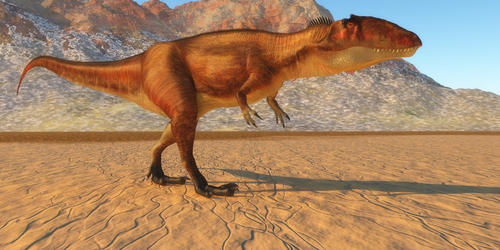Millions of years before the Tyrannosaurus rex roamed the Earth, another group of gigantic meat-eating dinosaurs reigned supreme in the Early to Mid-Cretaceous period.
The theropod, known as the Carcharodontosaurus, reached a truly enormous size, some growing even bigger than the icon of the Jurassic Park series.
Blade-Like Teeth of the Carcharodontosaurus
These enormous predators were amongst the largest to ever walk the Earth. They roamed North Africa around 99 million years to 94 million years ago, and Carcharodontosaurus measured around 12 meters in length, around the same as T. rex, andweighed an estimated six tons.
As well as its characteristic serrated, blade-like teeth, a study published in 2022 suggests it had a weaker bite force than T. rex, pointing to a particular hunting style. It’s thought these teeth were used to slash through and tear flesh, rather than crunch down with a bone-breaking strike.
Though not known for sure, it’s believed that Carcharodontosaurus and similar species feasted upon the soaring sauropods, giant herbivores that roamed the Earth at the same time.
“We have found many isolated carcharodontosaurid teeth in sauropods,” says Juan Ignacio Canale, an expert on the Carcharodontosaurus anda paleontologist with the National Scientific and Technical Research Council in Argentina. “We don’t know if they killed them or were scavenging them, but we know for sure that they were eating them.”
As Canale explains, the Carcharodontosaurus dinosaur is the African representative of the family of carcharodonotosaurs, which spread far and wide into the Americas and Asia. As a group these dinosaurs were truly massive, with two other members – Giganotosaurus and Mapusaurus – potentially reaching as much as 14 meters in length, and weighing over eight tons. This family also includes the truly bizarre dinosaur Concavenator, a far smaller shark-toothed dinosaur known for its peculiar sail on its back.
Read More: How Shark-Toothed Dinosaurs Came to Rule the World
The Carcharodontosaurus Discovery
Carcharodontosaurus was the first dinosaur of this group to be discovered. French biologists unearthed two teeth in the 1920s and originally assigned them to Megalosaurus, a large theropod from the Jurassic period.
Canale explains how at that time, many large theropods species wrongly found their way into the Megalosaurus group; it was something of a catchall species for difficult-to-identify fossils.
A few years later, Ernst Stromer, a German paleontologist, discovered a well-preserved fossil set of a gigantic theropod in Egypt, noting similarities with the previously recovered teeth.
Ultimately, he named it Carcharodontosaurus, meaning lizard with shark teeth. That’s because Stromer remarked upon the similarity of the dinosaurs’ serrated teeth with that of a group of sharks which includes the Great White; Carcharodon.
Unfortunately, for paleontologists this specimen was completely destroyed during World War II and for many years scientists only had drawings and descriptions of this species to go on, Canale says.
In the 1990s, paleontologists found a skull in Morocco that they labelled as Carcharodontosaurus saharicus. Around a decade later, another team found fossils in Niger that described a similar giant theropod but from a different species; it became Carcharodontosaurus iguidensis.
Read More: As Meat-Eating Hunters With Strong Jaws, Theropods Ruled the Mesozoic
Different Dinosaur Arms
Many of the larger meat-eaters within the Carcharodontosaurus family are largely distinguished by their enormous size, ornamental skulls which had distinctive bumps and ridges, their body shape, and their blade-like teeth, says Canale.
One of the most important differences is the arms; the carcharodontosaurids had three fingers on their shrunken arms while the Tyrannosaurids, by contrast, had only two. A few years ago, Canale’s team discovered a new carcharodontosaurid species in Argentina – Meraxes gigas – that measured around 11 meters, weighed over 4 tons, and had its own unique features in its remarkably well preserved feet.
“The second claw of the second toe is much larger. It’s not the same but it’s like what you can see in the raptors,” says Canale.
It’s not known exactly how these meat-eaters made use of this elongated claw, or if they did at all. But Canale and his colleagues believe it may have been common amongst other carcharodontosaurs.
Read More: Why These 4 Massive Dinosaurs Also Had the Tiniest Arms
The Carcharodontosaurus Grew Slowly
A lack of fossilized feet from other species complicates this assessment. Damiano Palombi, a Ph.D. student in Canale’s lab, believes the claw may have had some function when the dinosaurs were young and become obsolete later in life.
Another possible peculiarity amongst the carcharodontosaurs is their prolonged growing periods, says Canale. Whereas some large predators, such as tyrannosaurs, grew very quickly, it appears that the shark-toothed dinosaurs may have taken a far longer time to reach their gargantuan sizes.
“We know that in Meraxes gigas, at least, its growth was very slow, and it took at least 28 years to reach its size,” he explains, based on slices of bone sections that allowed his team to reach this conclusion.
This dinosaur was somewhere between 39 to 53 years old when it died, making it one of the oldest known ever found.
“We would have to do similar analysis with other carcharodontosaurid specimens to see if there is a similar pattern in other species or if each has a different growth strategy,” says Canale.
Ultimately, these giants died off quite suddenly along with many other groups of dinosaurs, for reasons that remain unclear to paleontologists. By the middle cretaceous period, they had begun to be replaced by other giant predators such as the abelisaurids and tyrannosaurids, of which T. rex is a notorious member.
Read More: How Sauropods Evolved to Their Enormous Size
Article Sources
Our writers at Discovermagazine.com use peer-reviewed studies and high-quality sources for our articles, and our editors review for scientific accuracy and editorial standards. Review the sources used below for this article:
Sean Mowbray is a freelance writer based in Scotland. He covers the environment, archaeology, and general science topics. His work has also appeared in outlets such as Mongabay, New Scientist, Hakai Magazine, Ancient History Magazine, and others.
Source : Discovermagazine






